weight VOLKSWAGEN GOLF 2008 Owner's Manual
[x] Cancel search | Manufacturer: VOLKSWAGEN, Model Year: 2008, Model line: GOLF, Model: VOLKSWAGEN GOLF 2008Pages: 444, PDF Size: 92.7 MB
Page 156 of 444
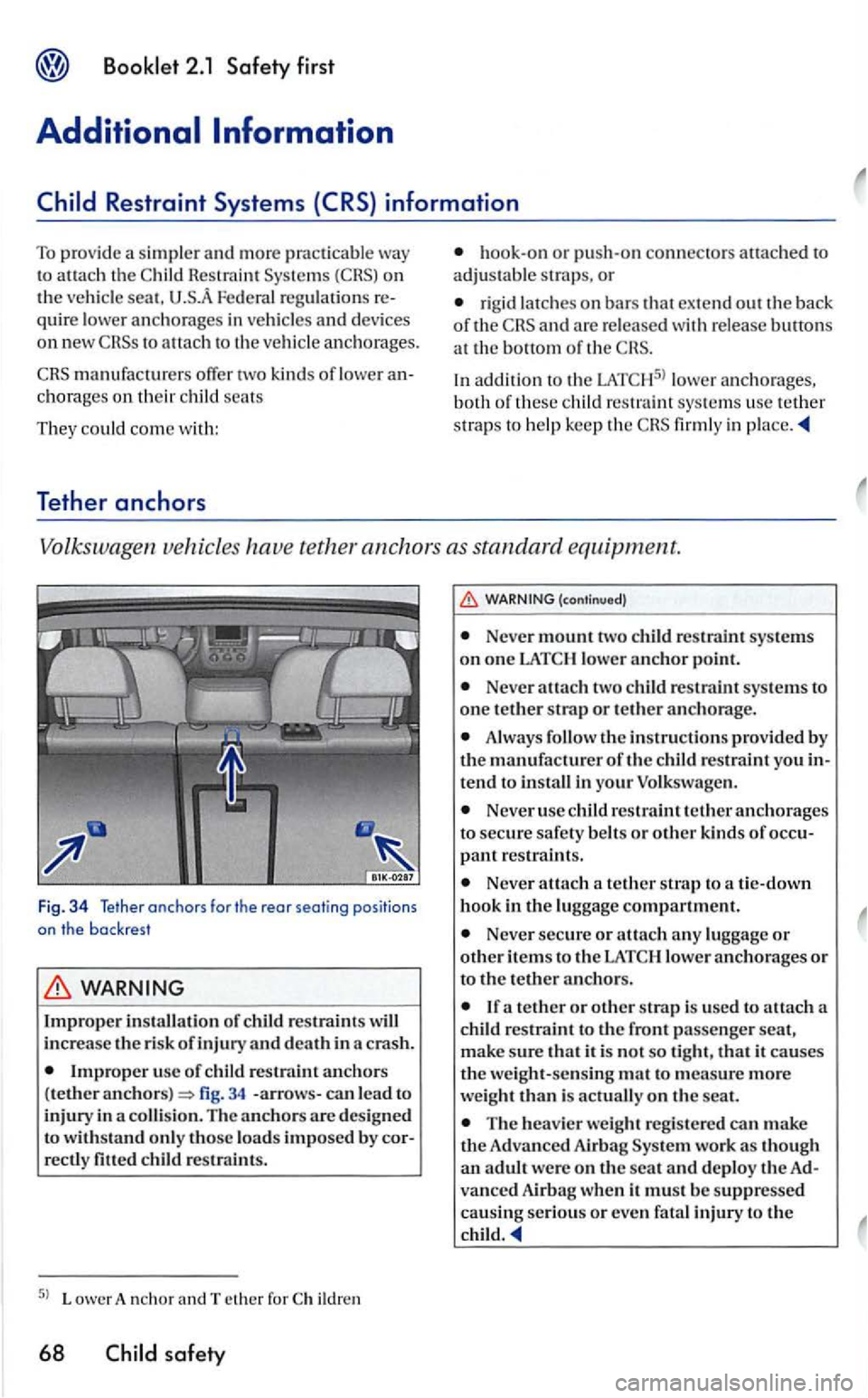
to attach the Res tra int on th e veh icle seat. Fe deral regularions quire lower anchorage s in vehicle s and devices to attac h to th e ve hicle anc horages.
ch o rage s on their chi ld sea ts
They could come w ith :
Tether anchors
hook-on or pu sh- on con nec tors att ached to
adjustable straps, or
rigid latc hes on bars that exte nd out the back of the e ns and are re lease d with release butto ns at th e bo tto m of th e ens.
I n add
ition to the l ower anchorages,
bo th o f thes e child res traint use te th er
stra p s to help keep the e ns firml y in place
Volkswagen vehicles have tether anchors as standa rd equipment.
Fig. 34 Tether anchors for the rear seating positions on the backres t
Improper use of child restraint anchors
( tether fig . 34 -arrows -can lead to
injury in a collision. The an ch ors are de signed
to with stand only those loads impos ed by rectly fitted child restra int s.
Lower A nch o r and Teth er for ildr en
68 safety
(co ntinu ed)
Never mount tw o child re strain t systems on one
Never att ach two child re stra int sys tems to one tether strap or tether anchorage.
Always follow the instructions pro vided by tl1e manufacturer of the c hild restrain t yo u tend to install in your Volkswag en.
Neve r use child restra int tether anch o rages
to secure safety belt s or other kind s of
Never attach a te ther to a tie-d ow n
hook in th e lugga ge compartment .
Neve r secure or attach any lug gage or oth er it ems to th e lower anchorages or
to the tether anchor s.
If a te ther or other strap is used to attach a
c hild res traint to the front passeng er seat,
m ake s ure that it is not so tig ht, th at i t ca uses the weight- sensing mat to measure more
we ight than is actuall y on the seat.
Th e heav ie r weight registe red can make Advanced A irba g work as th ough an adult were on the sea t and deploy the vanced Airbag when it must be suppresse d
causing serious or even fatal injury to th e
c hild
Page 157 of 444
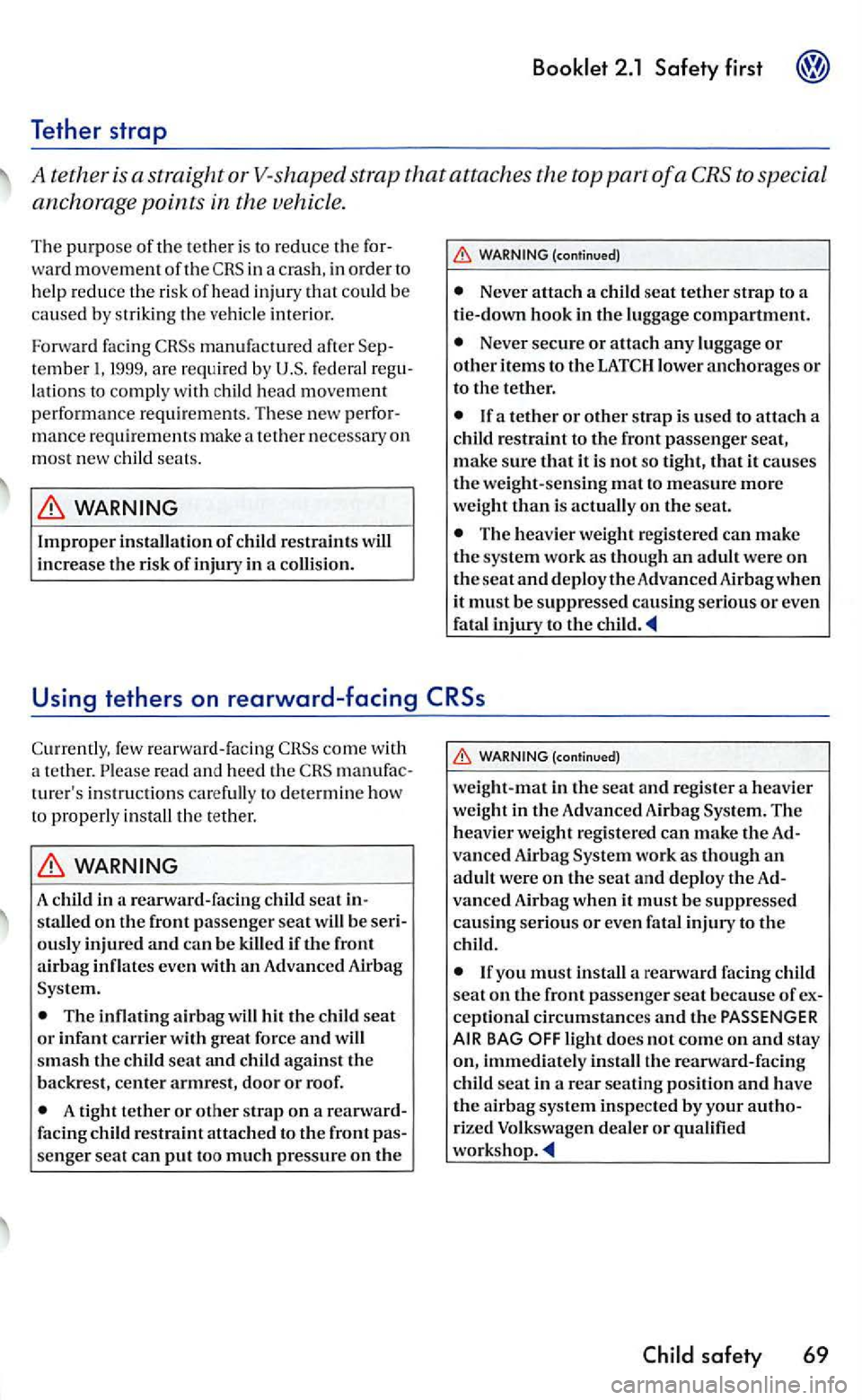
ward movem ent of the in a cras h, in order to h elp reduce the risk of head injury that could be caused by s triking the vehicl e interior.
Forward facing
manufactured after tember
Never attach a child seat tether strap to a
tie-down hook in the luggage compartment.
Never secure or attach any luggage or other items to the
tether or other strap is used to attach a
child restraint to the front passenger seat, make sure that it is not so tight, that it causes the weight-s ensing mat to measure more weight than is actually on the seat.
The heavier weight registered can make the system work as though an adult were on the seat and d eploy the Advanced Airbagwhen
it must be suppressed causing serious or even
fatal injury to the
f e w rearward- facing
turer's in struc tion s carefull y to determin e how
t o properly install the tether.
A child in stalled on the front passenger seat will be
The inflating airbag will hit the child seat or infant carrier with great force and will smash the child seat and child against the
backrest , center armrest, door or roof.
A tight tether or other strap on a facing child restraint attached to the front senger seat can put to o much pressure on the
Page 228 of 444
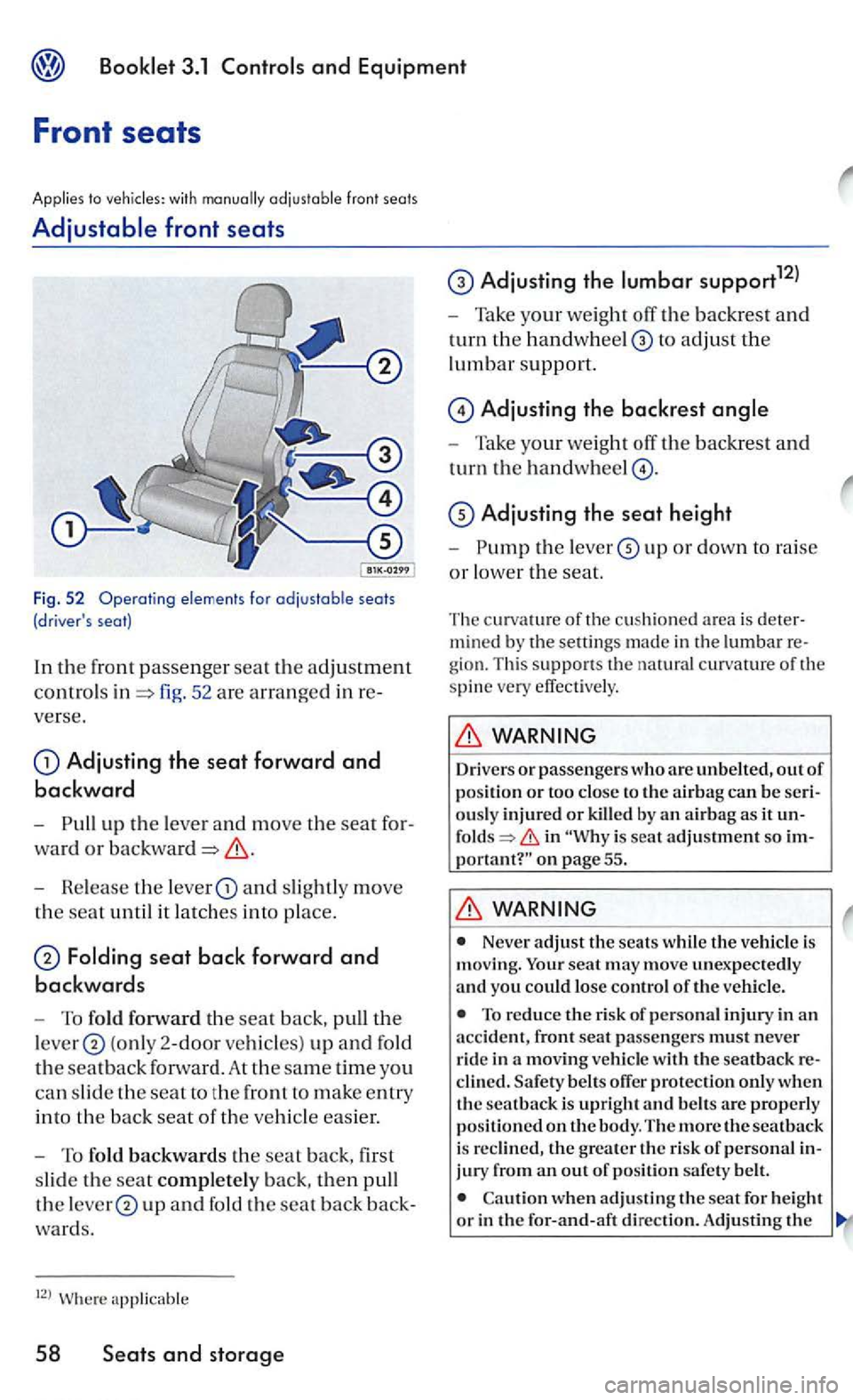
adjustable front seats
fig. 52 are arranged in
Adjusting the seat forward and
backward
-up the lever and move the seat
ward or
- Release the lever and slig htl y move
the seat until it la tches into place .
seat bock forward and
backwards
-To fold forward th e seat back, pull tl1e
(only 2-door vehicles) up and fold
th e
seatback At th e same time you
can slid e th e seat to th e front to make entry
into t he bac k seat of the vehicl e easier.
- To fold backwards the seat back, first
s lide the seat completely back, then pull
th e up and fold th e seat back
W here appl icabl e
58 and storage
Adjusting the support12l
-Take your weight off the backrest and
turn the to adjust the
lumbar support.
Adju sting the backrest
- Take your weight off the backrest and
turn the
up or down to raise
or lower the seat.
T he curvature of the cu shioned area is mined by the senings made in th e lumbar gio n. This s up pons the natural curvature of the spine ve ry effect ively.
WARNING
Drivers or passen gers who are unbelted, out of positio n or too close to the airbag can be
in is seat adjustment so on page 55 .
WARNING
Never adjust the seats whil e th e ve hicle is
moving. seat may mov e unexpected ly
a nd you could lose control of the vehicle.
To reduce the risk of personal injury in an accide nt, front seat passengers must n eve r
ride in a moving ve hicl e with the seatback
jury from an out of position safety belt.
when adjusting the seat for height or in the far-and-aft di rec tio n. Adjusting th e
Page 239 of 444
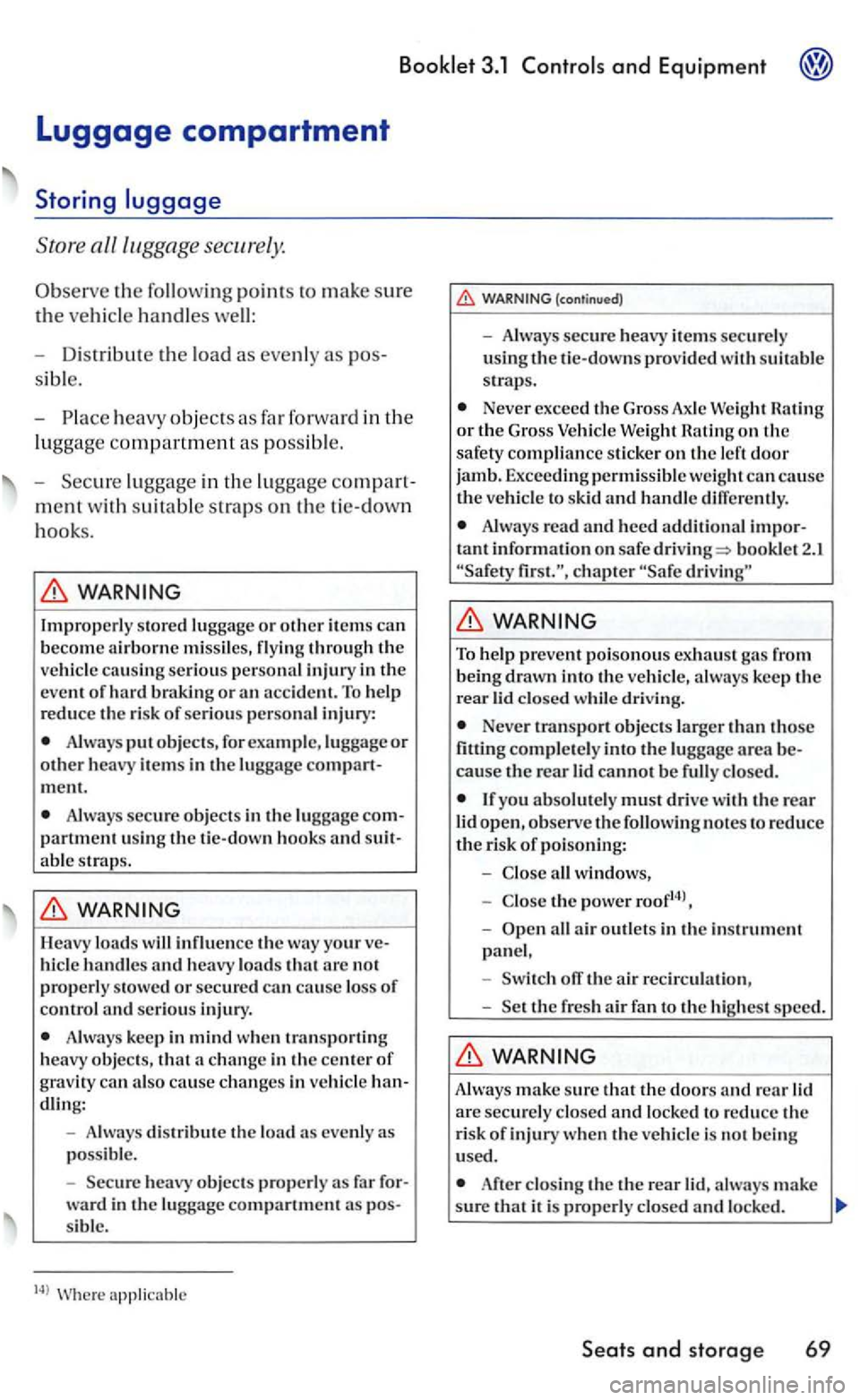
and Equipment
the following points to make sure
the ve hicl e handles well:
- D is tribute
the load as even ly as
heavy objects as far forward in the
lu ggage compartment as possibl e.
-
luggage in the lug gage compart
men t w ith suitable s traps o n the tie-down
hooks.
WARNING
Improperly stored luggage or other item s can become airborne mi ssi les, fly ing through the
ve hicl e ca using seriou s personal inju ry in the even t of hard braking or an acc ident. To help
reduce th e risk of serio us personal injury:
Always put objec ts , for example, lu ggage or other heavy item s in the lugg age compartment.
Always secure objec ts in the luggag e partment usi ng the ti e-down hook s and suit able straps.
WARN ING
Heavy loads will influ ence the way your hicl e handles and heavy loads that arc no t properly s towed or secured serious i njury.
Always keep in mind when transp o rtin g
heav y objec ts, that change in the center of g ravity can also cause ch anges in vehicle
eve nly as possible.
- Sec
ure heavy objects prop erl y ward in the compartment sibl e.
Where applicahlc
(con tinued)
- Alwa ys secure heavy item s securely
u sing the ti e-downs provided w ith suitable
straps.
Neve r exceed the Gro ss Axle Weight Rating or th e G ross Vehi cle Weig ht Rating on the safety compliance sticker on th e
Always read and heed add itional tant information on safe booklet 2.1 chapter driving"
WARNING
To help prevent po isonous exhaus t gas from being drawn into the veh icle, always keep th e rear lid
Never transport objec ts larger than tho se
fittin g co mpletel y into th e luggag e area cause the rear lid cannot be fully closed.
Lfyo u absolu te ly must drive wi th the rear lid open, observe the following notes to reduce the risk or poi soning:
-
the pow er roof14l,
-all a ir o utle ts in th e in strument pane l,
- Switch
the air recirculation ,
-
Set the fr es h air fan to the highe st sp eed.
WARNING
A lwa ys make sure that the doors and rear lid are securel y clo sed and locke d to red uce the
risk of in jury when the vehicl e is not bein g
u sed.
locke d.
Seats and storage 69
Page 292 of 444
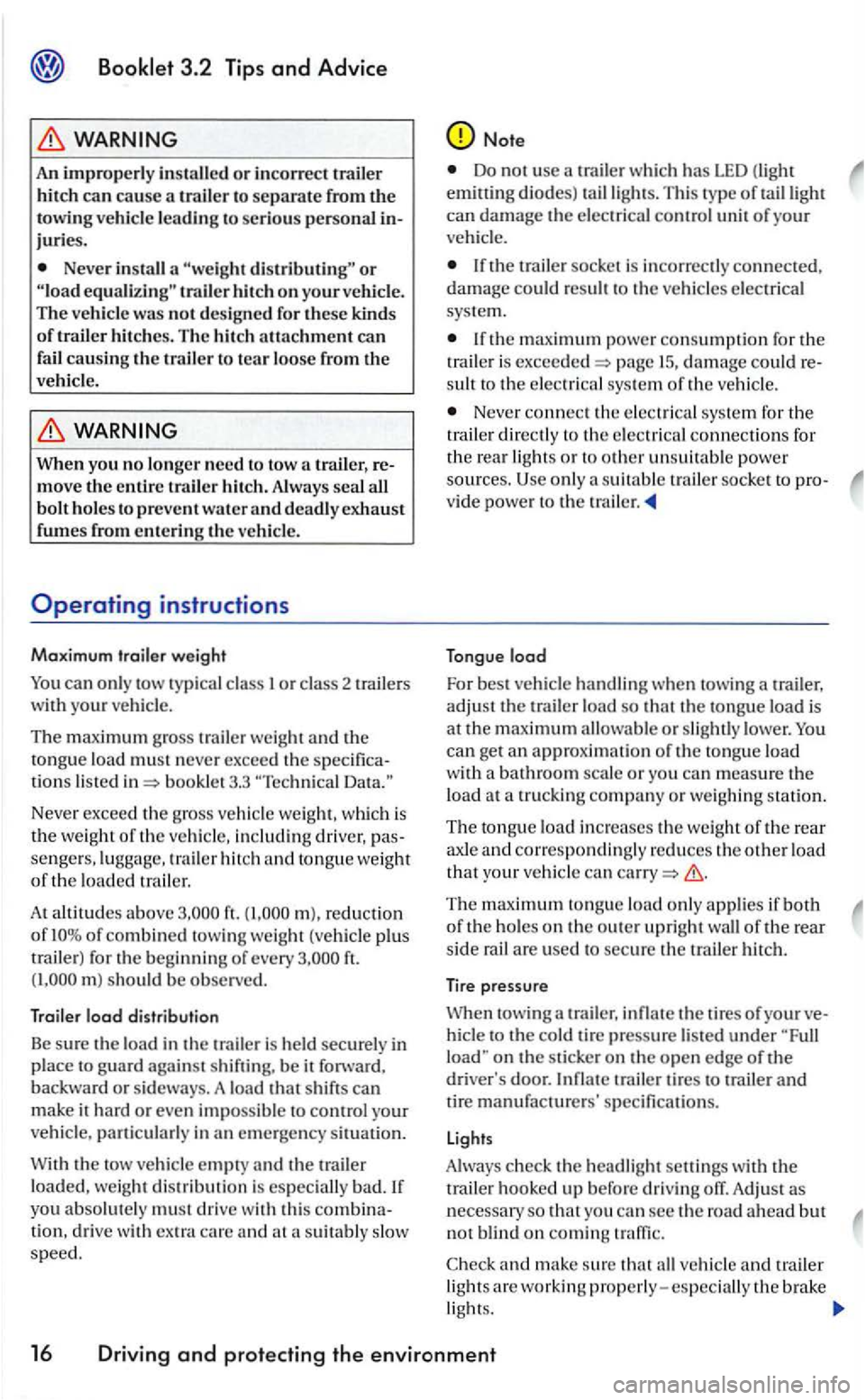
An improperly installed or incorrec t hitch from the towi ng vehicle leading to serious personal injuries.
Neve r in stall a on your vehicle . The vehicl e was not designed for these kin ds
o f trailer hitches. The hitch attachment to tear loose from the
ve hicl e.
When you n o longer need t o tow trailer, re
move the trailer hitc h . Alway s seal all bolt holes to prevent water and deadly exhaust fumes entering the ve hicle.
Operating instructions
Maximum trailer weight
You can only tow typical class I or class 2 trailers
with your vehicle.
T he m ax
imum gross trailer we ight and the tongue load must n ever exceed the specifica
tion s listed bookle t3 .3 "Tec hnical
Neve r exceed the gross ve hicl e we ight, w hi ch i s the we ight o f th e vehicle, includin g driver, passenge rs, luggage, trailer hit ch and tongu e we ight of the loaded trailer.
At alt itudes above ft. m), redu ction of of combined towin g weight (ve hicl e plu s trailer) for the beginning of every m ) should be observed.
Trailer l
oad distribution
Be sure the load in the traile r is held securel y in place to guard agains t be it forw ard.
b ackwar d or sideways. A load that shift s can make it hard or even impossibl e to control your vehicl e, parti cularly in an e m erge ncy situ ation.
W ith the tow vehicle empty and the trailer
l oade d , we ight distribution is es pecially bad. If
yo u absolut ely mus t driv e w ith this combina
tion, d rive with extra
Do not use a trailer whic h has LED (light emitting diodes) taillig ht s. This type of t a illi ght can damage the electrical co ntrol unit of your veh icle.
If the traile r socke t is in co rrectly connected .
damage co uld result to the ve hicles electrical
system.
I f th e maximum power consumption for the
trail er is pag e 15, damage could result to the e lectrica l sys te m of th e ve hicle.
Never connect the e lectr ical sys te m for th e
t raile r directly to the electrica l c o nne ctions for the rear lights or to other unsu itable power sources. Use onl y a su itab le trailer soc ket to pro
vide power to the trailer .
Tongue load
For bes t ve hicle ha ndli ng when towing a trail er, adjus t the trailer load so tha t th e tongue load is at the maximum allowable or slightly lower. You can ge t an approx imation of the to ngu e load
with a ba throom scal e or yo u can measure the load at a tru cking company or we ighing station.
The tongu e load incre ases the weigh t of the rear axle and correspondingly reduces the other load that your ve hicle ca n
The max im um tong ue load on ly a ppl ies if both of the ho les o n the o uter upright wall of th e rear side rail are used to secure the trailer hitch.
Tire pressu re
tow ing a trailer, inflate t h e tires of your ve
hicle to the col d tire press ure lis ted under on the sticker o n the open ed ge of the
dri ver's door. Inflate trailer tires to trai ler and tire manufactur ers' specificat ions.
lights
A lw ays check
the headlight settin gs wit h the tr ai le r hooked up before driving off. Adju st as n ecess ary so th a t yo u can see th e road ahead but not blind on coming
C he ck and make sur e th a t all veh icle and trailer lights are workin g properly -especially the brake light s.
16 Driving and protecting the environment
Page 293 of 444
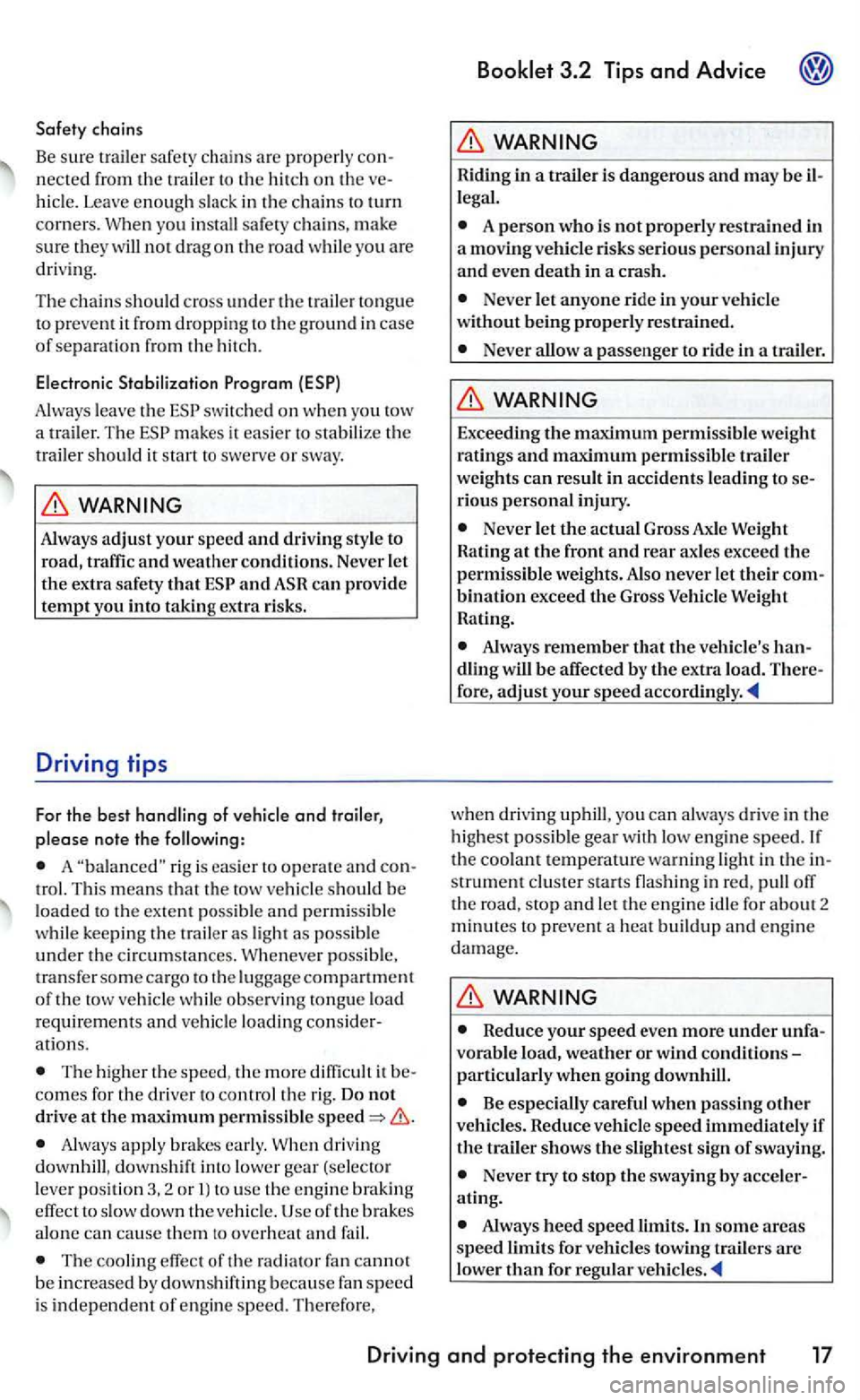
Safety chains
Be sure trailer safe ty cha ins are prop erly necte d fro m the trailer to th e hitch on th e hicle. Leave enoug h slack in th e c hain s to turn
corners. When you install safety ch a in s, mak e sure they will not dragon th e road whi le you are
driv ing.
Th e chains shou ld c ross
under th e trai le r to ng ue
to prevent it from dropping to the ground in case of separa tion from the hit ch .
Electronic Stabilization
Always leave th e mak es it easie r to stabilize the
t railer sho uld it start to swerve or sway.
Always adjust your speed and driving style to
road, traffic and weather conditions. Never le t the extra safety that and
A rig is eas ier to o pe rate and trol. Thi s means that th e tow vehicle should be loaded to the exte nt possibl e and permi ssibl e
w hil e keepin g th e t raile r as lig ht as possibl e under the ci rcumstances . Whenever possible, tran sfe r so me cargo to the luggage compartm ent
o f th e tow vehicle whil e observ ing tongue load requireme nts and ve hicl e loading ation s.
The hig her th e spee d, the more diffi cult it comes for the driver to control the rig. Do not drive at the maximum permissible
Always appl y brake s early . W hen dri ving
downhill , down shift into lower gear (selector leve r positi on
The cooli ng effect of th e fa n cannot
b e in cre ase d by dow nshif tin g because fan speed
i s independent of engine speed. Therefore,
Riding in a trailer is dangerous and may be
A person who is not properly restrained in
a moving vehicle risks serious personal injury and even death in a crash.
Never let anyone ride in your vehicle
without being properly restrained .
Never allow a passenger to rid e in a trailer.
Exceed ing the maximum permissible weight ratings and maximum permissibl e trailer
weights can result in accident s leading to rious personal injury.
Never le t the actual Gross Axle W eight Rating at the front and rear axles exceed the
permissible weights. Also never let their bination exceed the Gross Weight
Rating.
Always remember that the vehicle's
w he n dri vin g uphill, you can alwa ys drive in the
hi ghes t possibl e gear wit h low engin e speed. the coo lant tempe rature warni ng light in th e strument clu ster start s flas hin g in red, pull off
th e ro ad, s top and let th e engine idle for ab o ut 2 minutes to preve nt a heat buildup and eng in e
damage.
R educe your speed even more under vorab le load , weather or wind conditions
particularly when going downhill.
Be especial ly careful when passing other vehicles. Reduce vehicle speed immediately if the trail er shows the slightest sign of sway ing.
N ev e r try to stop the sway ing by ating.
Always heed speed limits.ln some a reas speed limits for vehicle s towing
Driving and protecting the environment 17
Page 294 of 444
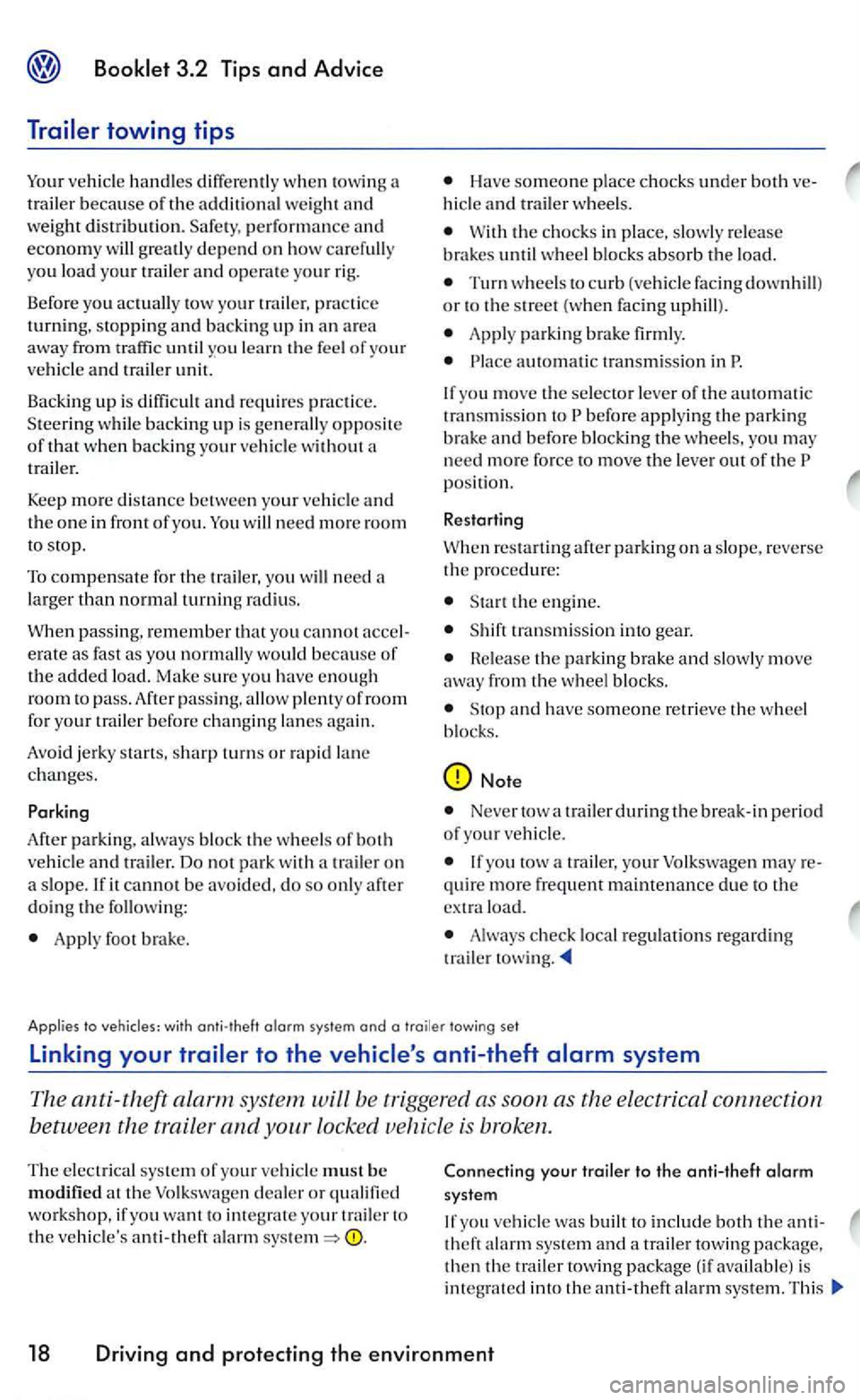
Booklet 3.2 Tip s and Advice
vehicl e handles diff ere ntl y wh en towin g a
tr ai ler because of the additional weigh t and weight distribution. Safe ty, pe rform ance and econo m y will greatl y depend on how carefull y
yo u load your trailer and op erat e your rig.
Before you actually to w your trail er, p ractic e
turning. stopping and b ack ing up in an area away from traffic until learn the feel of your vehicle and trail er unit.
Backing
up i s diffi cult and requi res practi ce.
Stee rin g whil e backing up is gen erall y opposite of that when backin g your vehicl e with out a
trailer.
Keep
more distance between your vehicl e and the one in front of yo u. will need more room to stop.
To compensate for the trail er. you will need a
larger than normal turning radius.
When passing, remember that you cannot erate as fast as you normally would because of the added load. Make sure yo u have enough
room to pass. After passing. allow plenty of room for you r trailer before c hanging lanes again.
Avoid je rk y s tart s, sharp turn s or rapid lan e changes.
Parking
After parking. always block th e wheels of both ve hicl e and trail er. Do not park with a traile r on a slope. If it cannot be a voided, do so only after doing th e follo wing:
Apply fo ot brake .
Have someone place chocks under both hicl e and trail er whee ls .
With the c hock s in place, s lo w ly re lease brak es until wheel blo cks absorb the load.
Turn w heels to curb (ve hicl e facing downhill)
o r to the stre et (when facing uphill).
Appl y parkin g brak e firmly.
automatic transmi ssion in
If you move the selecto r leve r of the automatic tran smission to
position.
Restarting
When restarting after parkin g on a slop e, reverse
the proc edure:
S tart the engine.
S hift transmission into gear.
le a se the parking brake and slowly move away from the wheel block s.
Stop and hav e someone re trie ve the wheel
b lock s.
Note
Neve r to w trailer during the break-in period of your vehicl e.
If yo u tow a trailer , yo ur Volksw age n m ay quire more frequent maimenance due to the
ext ra load.
Always check local reg ulations regardi ng
trailer to w in g.
Applies to vehicles: with anti-theft a larm system and a traile r towing set
Linking your trailer to the vehicle's anti-theft alarm system
The anti-theft alarm syste m will be triggere d as soon as the ele ctrical connec tion
between the trailer
and
or qualified
wo rkshop, if you want to inte grat e your trai le r to th e ve hicle's anti-theft a larm
Connecting your trailer to the anti-theft alarm syste m
If yo u ve hicle was built to include both the th eft al arm system and a trailer towin g th en t he trail er towing package (if available) is
in tegrated into the anti-theft alarm sys te m . Thi s
18 Driving and protecting the environment
Page 334 of 444
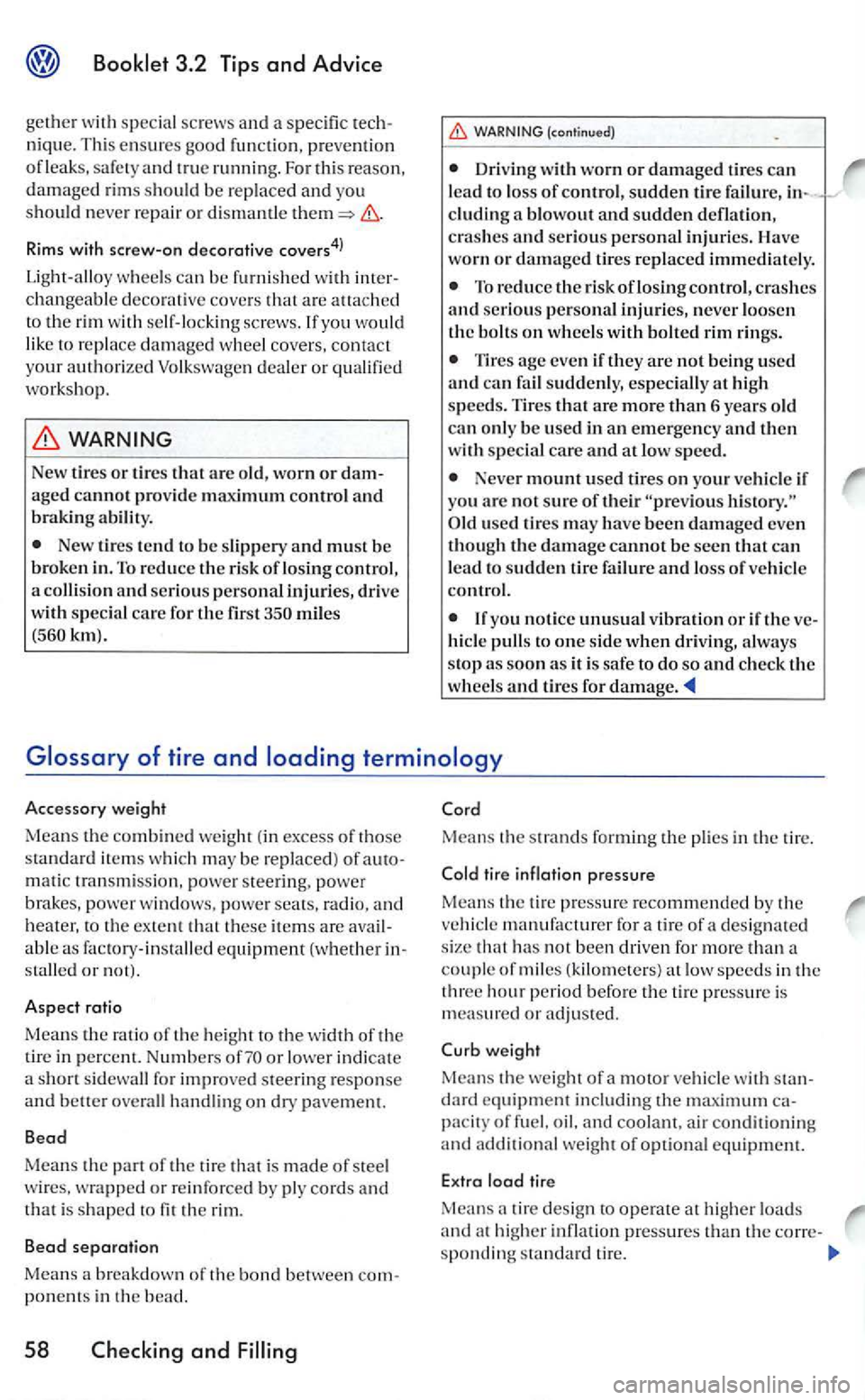
changea ble deco rat ive cove rs a re att ached to th e rim with s elf- locking sc rews . lfyou would ro re pla ce damaged wheel covers, contact your authorized Volkswa gen d eale r or
WARNING
New ti res or tires tha t are old, worn or aged cannot provide maximum control and braking ability.
New tires tend to be s lipp ery and must be broken in . To reduce the risk of losing co ntrol,
a co llisio n and serio us personal injuri es, drive with sp ecia l care for the first km).
(cont inued )
Driving with worn or damaged tire s can lead to lo ss of control, sudden tire failur e, cluding a blowou t and sudden deflation ,
c ras hes and seriou s personal injuries. Have wo rn or damaged tires rep laced imme di ate ly.
To redu ce the riskoflosingcontrol, crashes and s erio us personal injuries, never loose n
th e bolts on w heels with bolted rim rings.
more than 6 years old can onl y be used in an em erg en cy and then
w ith specia l care and at low speed.
Neve r m ount u se d tires on your ve hicle if
yo u are not sure of their used tires may have been damaged ev e n
t h oug h the damage cannot be seen th at can
lead to sudden tir e failure and loss of ve hicl e control.
hicl e pull s to one sid e when dri ving, always
s top as soo n as it is safe to do so and ch eck the
whee ls and tires for damage.
Accessory weight
Means the combined we ight ( in excess of those
sta ndard ite m s w hi ch may be repl aced) of mati c tran smission. power steering. po wer
bra kes, power windo ws. p owe r seats , radio, and heater, to th e ex te nt th at th ese item s are
or lowe r indica te
a short s id ewall for improved steering respo nse and better ove rall handling on dry pave ment.
Bead
Mean s the pa rt of the tire t hat is m ad e of stee l
wires , w rap ped or re inforce d by pl y cords and that is shap ed to fit t he rim.
Bead separation
Mean s a breakdow n of th e bond between
Means the strand s forming the in th e tire.
weight
Me ans th e weig ht of motor vehicl e w ith dard equ ipment including the m aximum pacity of fu el, oil. and coolant . a ir conditio nin g
a nd additional weight of opt io n al equipm ent.
E xtra load lire
M ea ns tire desi gn to operate at higher loads and at hi gher inflat ion pressure s th an th e corre -
s ponding sta ndard tire.
Page 335 of 444
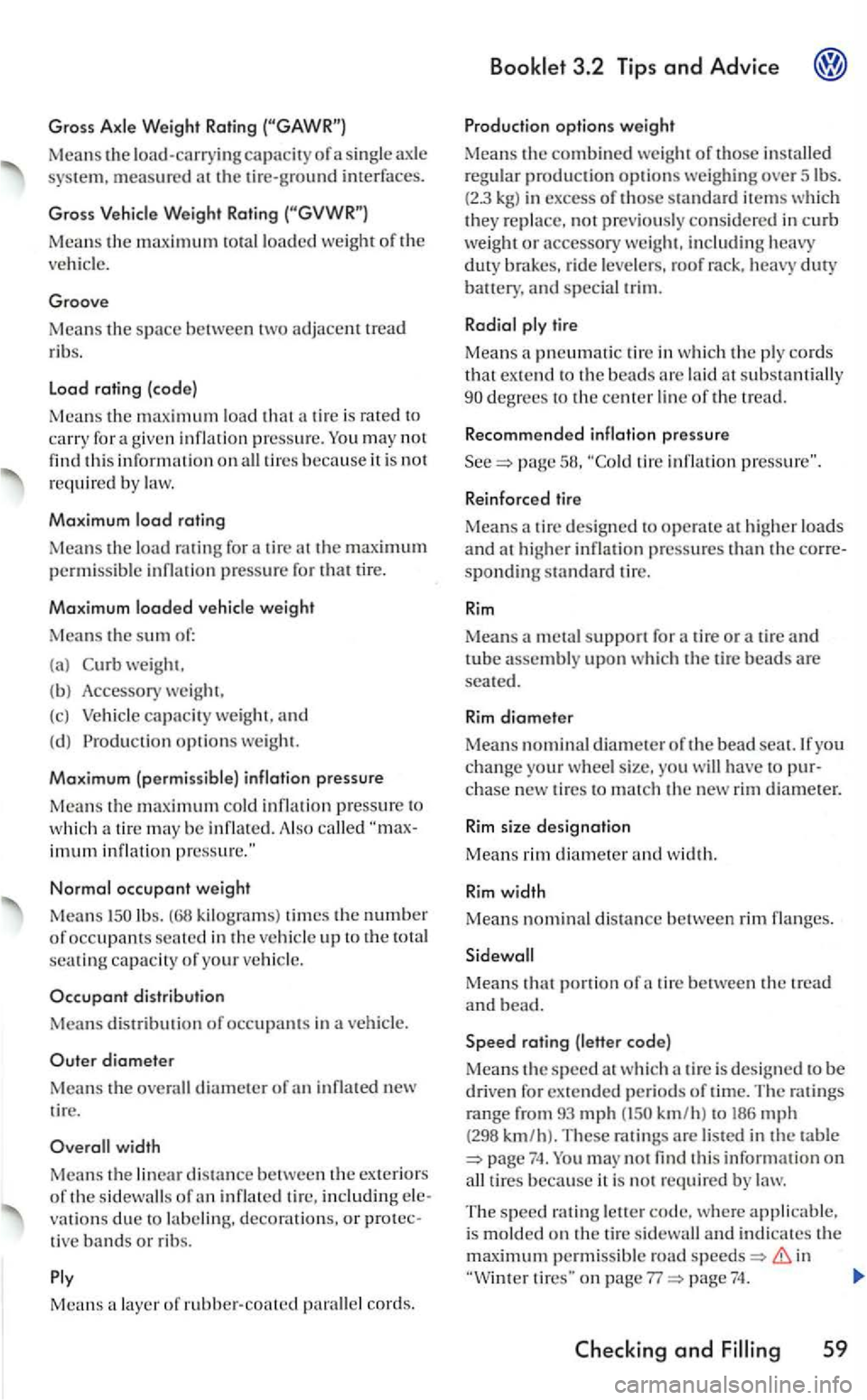
Gross Axle W eight Ra ting
Mea ns the load-carryin g capacity of a sing le ax le
Mean s th e maximumlOtalloaded weight of the
ve hicle.
Groove
Means the space between adjacent tread
r ib s.
L
oad ratin g (cod e)
Means the load th at a tire is rated to
carry for a give n inflation pressure. You may no t find thi s information o n all tires because it is not require d b y
Maximum load ratin g
Means the load rating for a tire the m aximum permiss ib le inflation p ressure for that tire.
Maximum loaded vehicle weig ht
Means th e sum of:
( a)
weig ht.
( b ) Accessory
weight,
(c) Vehicl e capacity weig ht. and
(d ) Production o pti ons
b e inflat ed. A lso called imum inflatio n pressure."
Normal oc cupant weight
Means lb s. kilog ra ms} times the n u m ber of occupants sea te d i n the ve hicl e up to the seating capacity of your vehicle.
O c
cupant distr ib ution
Means dist ributio n of occupants in veh icle.
Outer d iameter
Means the overall diameter of an inflated new tir e.
inflated including vations due to or tive bands or rib s.
P ly
M
ean s layer uf parallel cord s.
Productio n optio ns weight
Means the com bined weight of those installed
regular produc tion options weighing over Sibs. (2.3 kg) in excess of those standard items whic h they replace, not previously considered in curb weight or accessory
pne u matic tire in which the pl y cords th at ex tend to the beads a rc laid at substa n tially degrees to the center lin e of the tread.
Re commended inflat io n p ressure
page tire inflation p ressure".
Reinforc
ed tir e
Means a tire designed to operate at higher loads and at higher inflation pressures than the sponding tire.
Rim
Means a m etal support for a tire or a tire and tube assembly upon whic h the tire beads are seate d .
Rim d iameter
Means nominal diameter oft he bead seal. you change your w heel size. you will have to
Means that portion of tire between the tread
and bead.
which
km/h) mph ( 298 k.m/ h ). These rat ings are lis ted in the table 74. You may not find this information on all tire s because it is not required by law.
The speed r ating lett er cod e, where is molded on the tir e s idewall and indicates the maxjmurn permissible road in on page 77 74.
Checking and
Page 336 of 444
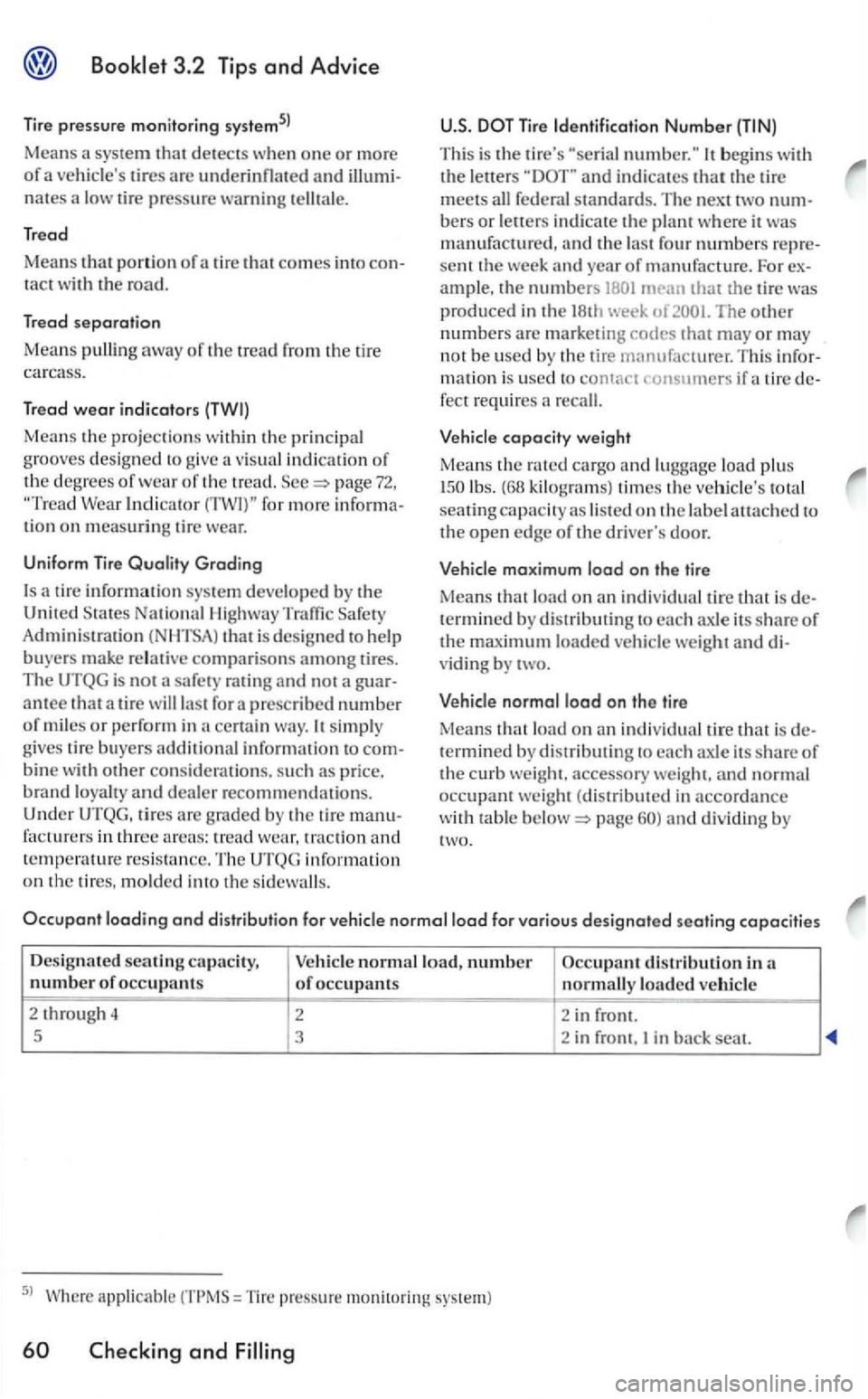
3.2 Tip s and Advice
Tir e pressure monitoring
tires are underinflated a nd nates a low tire pressure warning tellt ale.
Tread
Means that porti on of tire that comes into tact the road.
Tread separation
Means pulling away of the tread from the tire carcass.
Tread wea r indicators
visual indication of the degrees o f w ear of th e tread. page 72,
Wea r for more tio n on measurin g tire wear.
Un iform
Tire Quality Grading
that is designed to help buyers make re la ti ve comparisons among ti res. The UTQG is not s afety rating and not a
antee that a tire la st for a prescrib ed number of miles o r perform in simply
g ives tire buyers additional information to bin e w ith other consideratio ns. such as price. brand loya lty and dealer recommendations. Under UTQG, tires arc graded b y th e tire fac turers in three areas: tre ad wear, traction and temperature resistance. The UTQ G information o n the tires, molded into the s idewall s.
This is the tire's "ser ia l begin s w ith the letters
sent week and year of manufacture. For ample . the rnran that the tire
pro duced in the 18th The other numbers arc m arketin g codes that no t be used by th e tire manufacturer. T his mation is used to if a tir e fect requires a recall .
Vehicle
capacity weight
Means the cargo and load plu s lb s. (68 kilograms) times the total
s
eatin g capacity as lis ted on the label attached to the ope n edge o f the driver's door.
Vehicle
maximum load on the tire
Mean s that load o n an indi vidual tire that is t ermined b y di stri buting to each axle its share of the maxim um loaded weight and viding by
normollood on th e tir e
Means that load o n an indiv idual tire that i s termined by di stribut ing to axle its sh a re of the curb weigh t. accesso ry weight. and normal occupant weight (di stributed in accordance with table page and di viding by
Occupant loading and distribution for vehicle normal load
normal load, number Occupant distributio n in number of occupants of occupants normally loaded
2 through 4
2 2 in fro nt.
5
3 2 in front. I in
=Tire pres sure
Checking and